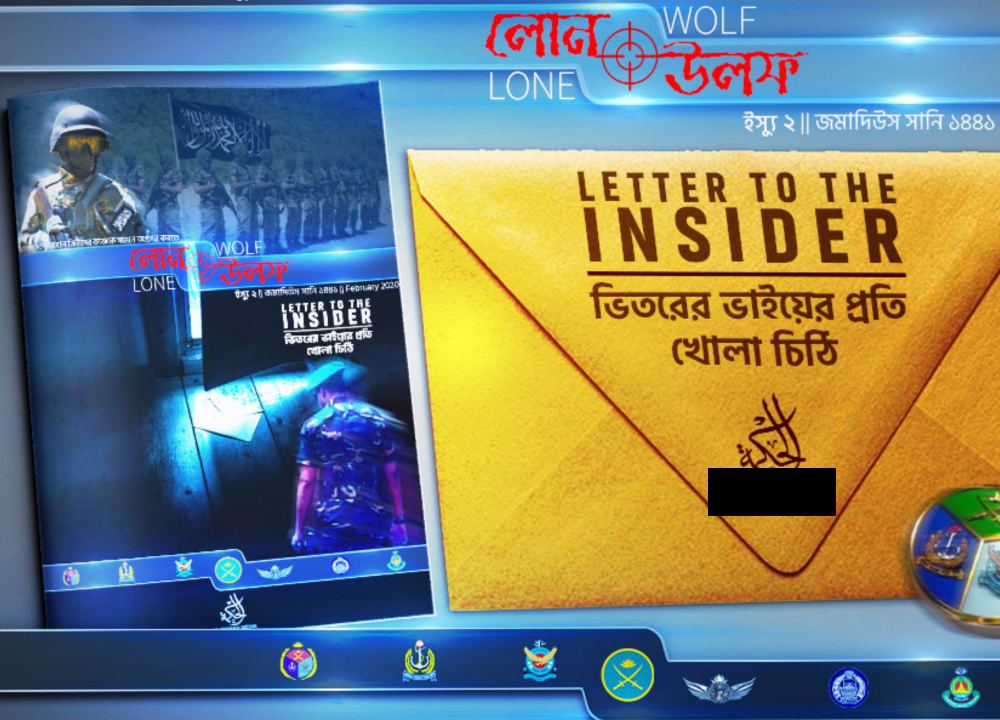Military dawah
Al Qaeda calls on “lone wolves” inside Bangladesh security forces to target US, Indian ambassadors.

In the middle of February this year, the second issue of the Lone Wolf magazine was published in Bangla by a group of Bangladeshi jihadis loyal to Al Qaeda in the Indian Subcontinent (AQIS). The stated mission of this magazine is “taking forward global jihad in Bangladesh.” This 53-page magazine follows the high production quality that has been a hallmark of this group in the past five years. The target audience of this publication is made absolutely clear on the front cover. It is titled “Letter to the insider” and the cover carries the logos of Bangladeshi security forces. The Bangladesh Army logo is prominently in the middle, along with the logos of the Bangladesh Navy, Bangladesh Airforce, police, Rapid Action Battalion (RAB) and Special Security Force (SSF). The inclusion of the SSF logo is especially notable. There is also the tri-service logo of the Bangladesh Armed Forces. The latest issue of the magazine is solely dedicated to the serving members of Bangladeshi security forces.
The logic and reasoning presented by the jihadis in support of jihad is complex, highly developed, and often appears authoritative to a person of faith. A regular religious person may find it difficult to challenge. The arguments presented are a result of decades of theological debates and deliberations by the global jihadi ideologues. This magazine follows the same pattern, with the message presented in the articles following the typical methods used in jihadi radicalising.

A diagnosis of the contemporary world is provided where oppression of Muslims around the world is detailed, the Muslim rulers of the world are declared as taghut (rulers who defy God’s absolute power and laws), and “forces” that assist the taghut are promised hellfire. Those who fight for and protect the taghut are declared as kafirs. The engagements between Bangladeshi and US military forces are noted and criticised. A comparison between “God’s army” and the Bangladesh Army is presented through an infographic.
This leads to the prognosis which unsurprisingly proposes armed jihad as the only solution. The magazine urges the reader to become a “one-man army” while working inside the taghut as a “covert operator”. This is suggested as the most effective path. There are three cases of insider lone actor attacks presented as examples: Nidal Hasan, the US Army major who killed US military personnel at Fort Hood (Texas) in 2009; Muhammad al-Shamrani, the young Saudi officer who attacked the Pensacola Naval Air Base in Florida, in December 2019; and, Mevlüt Altıntaş, the Turkish police officer who assassinated the Russian Ambassador Andrei Karlov in front of live media in Ankara, in 2016.
To inspire its readers to become insider lone wolves, the magazine utilises various motivational messaging that includes the usual usage of Quranic authority and guidance from the Sunnah. Historical anecdotes are presented, the faith of the Muslim is appealed to, and the strength of the religion is placed forward as assurance of final victory.
The magazine lists a number of impacts that result from lone actor attacks. One worth mentioning is the argument that qital (armed jihad through violent attacks) is a powerful dawah (invitation) in itself. Through this argument, the jihadis posit that a terrorist attack creates the possibility of many Muslims to re-evaluate their own beliefs (which can then open up the possibility of radicalisation). This is a novel argument, a new addition to the existing jihadi logic presented by these groups.
The AQIS affiliated group also released a short video along with the new issue of the magazine, to serve as a trailer. The video has the exact same target audience and includes similar messages, albeit a summarised version. This high-quality video comprising real footage appears designed to leave a powerful impact on the viewer, as these cunningly designed propaganda content are meant to do. A noteworthy aspect of this video is that it explicitly presents three potential targets for the insider lone actor attackers. These targets are the US Ambassador to Bangladesh Earl Miller, the Indian High Commissioner to Bangladesh Riva Ganguly Das, and the Bangladeshi Prime Minister Sheikh Hasina. This high-profile target selection is undoubtedly audacious, but the threat should not be taken any less lightly.
Sleekly produced magazines and videos, like the latest issue of the Lone Wolf magazine and its trailer, require jihadi groups to invest significant resources and assets, and so it would be reasonable to see them as indicators of AQIS’ current focus. It is interesting that AQIS appears to be publicly boasting about its methods, and this may well be because the radicalisation and recruitment of members inside the security forces are already going on. It would not be prudent to ignore these messages as they clearly indicate what the jihadis would like to see happening in Bangladesh in the near future.●
Asheque Haque (@ashequeh) is a political and security researcher. His research includes violent extremist propaganda, jihadi ideology in South Asia, and security challenges and practices in the region.